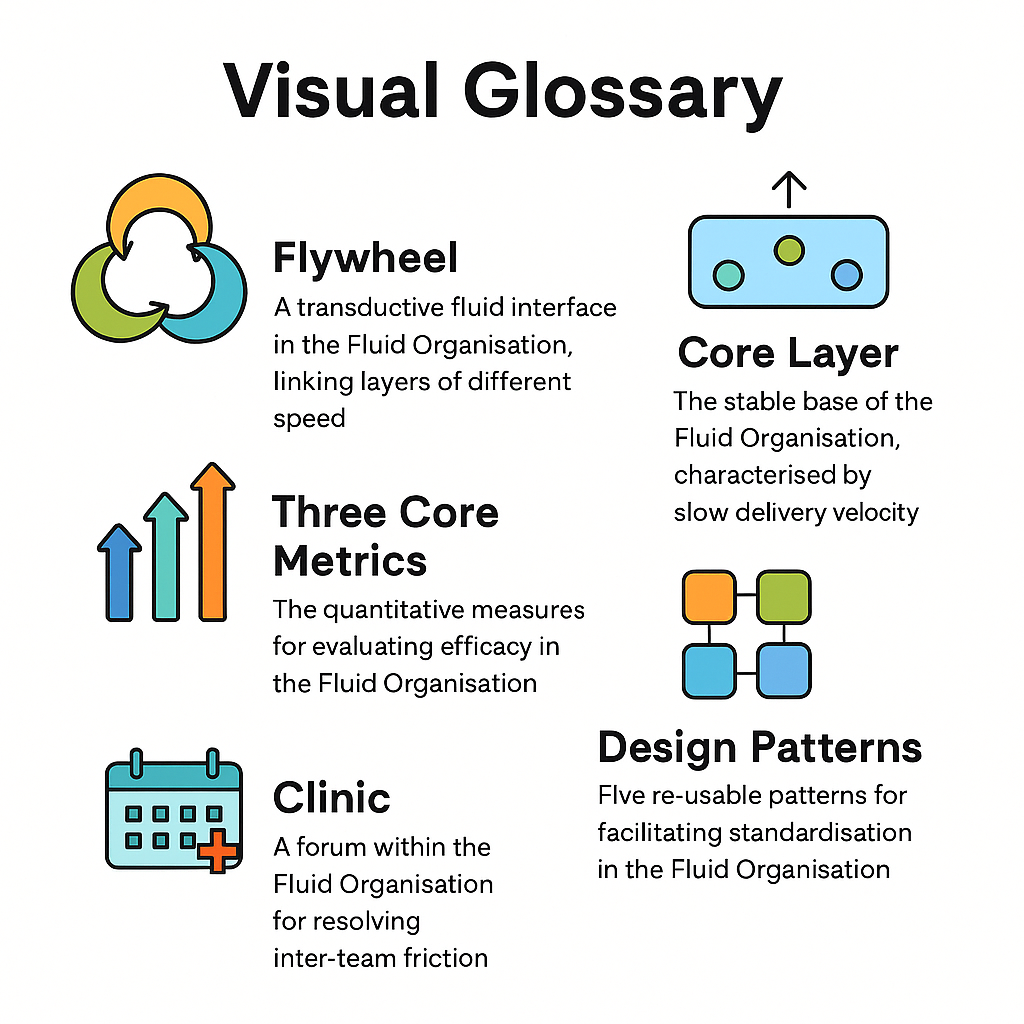How the Fluid Organisation Model Aligns Innovation, Reuse, and Scale

Introduction
The original problem is simple, but powerful: modern organisations deliver at different speeds across their layers. Product teams iterate quickly. Platform and infrastructure move more slowly. Governance moves slower still. Left unchecked, this mismatch turns velocity into fragmentation.
Speed alone does not scale. Alignment alone does not create coherence. Organisations today suffer not from slowness, but from signal decay, duplicated logic, fragile reuse, and an inability to evolve without entropy.
The Fluid Organisation was designed to solve exactly that.
Built on a foundation of layered motion and adaptive feedback loops, it offers not a new org chart, but a method to design and build adaptive organisations that can respond to structural tension in real time. A new way of governing complexity. It introduces a dynamic interface layer, the Flywheel, that transduces raw delivery into structured capability. Combined with three measurable metrics and five reusable patterns, the model allows for emergence without chaos, and standardisation without bureaucracy.
This article brings together our findings so far: what systemic problems the Fluid Organisation addresses, how it responds, and what that enables in practice.
System Problems the Fluid Organisation Was Built to Solve
- Innovation Without Reuse → duplication, instability, entropy
- Reuse Without Trust → poor adoption, brittle standardisation
- Tickets Without Flow → reactive, siloed platforms
- Speed Without Signal → fragmentation and invisible drift
- Governance Without Feedback → rigidity, slowdown, resistance
These problems are not workflow issues. They are symptoms of deeper systemic misdesign where structure fails to absorb velocity.
The Structural Response
The Fluid Organisation is built around multiple delivery strata joined by a transductive, adaptive interface. The Flywheel, at its heart, functions much like a gearbox. Inspired by the continuous variation of a CVT, it adapts to input signal and organisational load. Just as in planetary mechanics, where the Earth’s mantle transfers energy between the convective core and brittle crust, the Flywheel smooths, modulates, and transfers signal across organisational layers.
- Surface: Fast-moving product or discovery teams generating rapid delivery and change
- Flywheel: A dynamic interface that absorbs signal, filters entropy, and prepares reusable capability
- Core: Stable, foundational systems or platform components intended for scale and longevity
Rather than flattening organisational motion, the structure allows teams to move at their natural speed, while providing the connective tissue needed to metabolise change.

To observe, manage, and guide this structure in real time, the model introduces three foundational metrics. These are experimental in nature. They offer a practical starting point for feedback-driven transformation, and we expect teams to refine, remix, or extend them as the system matures:
- Org Re (Organisational Reynolds Number): Measures delivery-induced turbulence. High Org Re = speed without structural clarity.
- TQS (Transduction Quality Score): Measures fidelity of signal as it flows from idea to reusable capability.
- Entropic Pressure: Captures organisational strain from high change velocity against low maturity boundaries.
These are complemented by a growing set of secondary or situational indicators such as:
- Alignment Drift: Measures the gap between product intention and implementation outcome
- Feedback Latency: Tracks the delay between signal and triage
- Reuse Drag: Assesses the friction cost of adopting a reusable path
Together, they provide a system-level feedback layer that helps teams adjust, respond, and evolve without blindly scaling coordination.
The Fluid Organisation introduces three foundational principles:
- Layered Motion: Different teams move at different speeds, by design
- Transduction Layer (Flywheel): An adaptive middle that absorbs, filters, and packages motion from Surface to Core
- Metric Feedback: Tension is observable through Org Re, TQS, and Entropic Pressure
These are not abstract ideas. They are operational, testable, and incrementally adoptable.
Flywheel Patterns in Action
Throughout this article, we reference Flywheel patterns that help transduce chaos into structure. Here is a quick reminder:
- Shadow Integrators embed in fast teams to extract reusable logic close to delivery.
- Signal Clinics are scheduled sessions where platform or Flywheel engineers triage upstream requests live. These are not office hours but structured, proactive forums for turning inbound demand into signal.
- Pattern Shepherds observe emerging convergence and translate it into stable interfaces or paved paths.
- Reuse Jams are themed events where teams are challenged to solve using existing primitives.
- Flow Cells are temporary teams focused on a specific high-entropy domain until convergence is reached.
These patterns are not theoretical. They are shapes that teams can adopt, observe, and evolve.

What This Makes Possible
Because the Flywheel absorbs variation and filters volatility, the system is no longer limited by the weakest interface or the slowest team. The Flywheel allows change to be processed before it becomes chaos, and enables reuse to spread before it becomes enforced.
The model enables:
1. Fast teams that lift the system instead of fragmenting it
Fast-moving delivery no longer produces incoherence, because the Flywheel captures patterns in motion. Shadow Integrators and reuse-focused clinics allow innovation to be metabolised before it diverges. As a result, velocity fuels structure.
2. Signal-aware reuse that spreads by fit, not by force
Patterns are not imposed. They are recognised, packaged, and allowed to evolve. Pattern Shepherds frame convergence as opportunity, not enforcement. TQS ensures reuse happens because it works, not because it is mandated.
3. Standardisation through absorption, not imposition
The Flywheel acts as an absorber of variation. Flow Cells and domain-specific triage convert entropy into capability. Governance emerges organically as repeated variation gets codified into shared paths.
4. Governance through feedback loops, not ticket reviews
Flywheel metrics allow teams to observe structural risk early. Clinics replace escalation queues. Org Re and Entropic Pressure show where the system is over-strained or under-designed, so governance becomes responsive, not reactive.
- Fast teams that lift the system instead of fragmenting it
- Signal-aware reuse that spreads by fit, not by force
- Standardisation through absorption, not imposition
- Governance through feedback loops, not ticket reviews
When applied through Flywheel patterns (e.g. Signal Clinics, Pattern Shepherds, Flow Cells), teams metabolise innovation instead of resisting it. Friction becomes signal. Entropy becomes fuel.
Conclusion
Because the model is adaptive by design, the Fluid Organisation can scale up or down. It is not tied to company size, but to system complexity. Its Flywheel interface allows startups to evolve fast without breaking coherence, while giving scale-ups and large organisations a way to metabolise signal at scale without flattening innovation.
The Fluid Organisation is not a rigid structure. It is a living system.
It adapts to the shape of your organisation, but it cannot decide your intent for you. It makes alignment observable, not automatic. The model supports the design of an efficient, learning system, but it is people who must drive it with clarity, care, and intent. One that embraces change without losing coherence. One that measures what matters, not what is easy.
In a world of increasing delivery complexity, it offers a path not just to build faster, but to build better systems that learn from themselves.





Member discussion